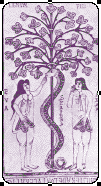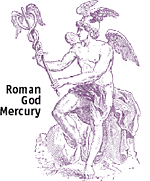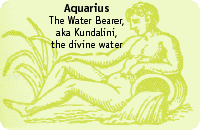 The
word Kundalini is derived from a Sanskrit word 'Kundal'
meaning coiled up. It is the primordial dormant energy
present in three-and-a-half, coils at the base of the
spine in a triangular bone called the Sacrum. The Latin
name 'Os Sacrum' suggests that it is a holy or sacred part
of the body. The ancient Greeks were aware of this and
therefore they called it the 'Hieron Osteon', noting that
it was the last bone to be destroyed when the body is
burnt, and also attributed supernatural powers to it.
Egyptians also held this bone to be very valuable and
considered it the seat of special power.
The
word Kundalini is derived from a Sanskrit word 'Kundal'
meaning coiled up. It is the primordial dormant energy
present in three-and-a-half, coils at the base of the
spine in a triangular bone called the Sacrum. The Latin
name 'Os Sacrum' suggests that it is a holy or sacred part
of the body. The ancient Greeks were aware of this and
therefore they called it the 'Hieron Osteon', noting that
it was the last bone to be destroyed when the body is
burnt, and also attributed supernatural powers to it.
Egyptians also held this bone to be very valuable and
considered it the seat of special power.
In
the West, Sacrum is symbolised by the sign of Aquarius and
by the Holy Grail, container of the water of life.
The
Kundalini, which is to nourish the tree of life within us,
is coiled up like a serpent and therefore it has been
called, 'the Serpent Power'. It has been described in
great detail in the Upanishads. Kundalini Yoga is supposed
to be supreme in all the Yogas. Guru Vashistha asserted
that Kundalini is the seat of absolute knowledge. The
awareness of the presence of this primordial energy
Kundalini within the human body was considered by the
sages and saints to be the highest knowledge. The
Kundalini and Chakras have been vividly described in Vedic
and Tantric texts.
 Adi
Sankaracharya
Adi
Sankaracharya
He lived in the 7th-8th century AD. and wrote:
'Having filled the pathway of the Nadis with the streaming
shower of nectar flowing from the Lotus feet, having
resumed thine own position from out of the resplendent
Lunar regions and Thyself assuming the form of a serpent
of three and a half coils, sleepest thou, in the hollow of
Kula Kunda (Kula Kunda means the hollow of Mooladhara
Sacrum bone)'.
'Saundarya Lahari': athou art residing in secrecy with Thy
Lord (The spirit) in the thousand petalled Lotus, having
pierced through the Earth situated in 'Mooladhara', the
Water in Manipura, the Fire abiding in the Svadhisthana,
the Air in the Heart ('Anahata'), the Ether above (Visshuddhi)
and 'Manas' between the eyebrows ('Agnya') and thus broken
through the entire 'Kula Path'.'
 Gyaneshwara
Gyaneshwara
Gyaneshwara, another famous saint of Maharashtra born
around 1275 AD, described Kundalini in the 6th chapter of
his famous book 'Gyaneshwari'. He wrote:
'Kundalini is one of the greatest energies. The whole body
of the seeker starts glowing because of the rising of the
Kundalini. Because of that, unwanted impurities in the
body disappear. The body of the seeker suddenly looks very
proportionate and the eyes look bright and attractive and
the eyeballs glow.'
- (Gyaneshwari, Chapter VI).
Guru Nanak Dev
(born in 1496 AD) has made references to Kundalini
awakening as mentioned below:
“A pure heart is the golden vessel to fill the Divine
Nectar which is to be sucked from the 'Dasham Dwar'
through the two channels 'Ida' and 'Pingala'.”Dasham Dwar
means Brahmarandhra. (Sahasrara Chakra).
'God has made this human body a house with six Chakras and
has established the light of spirit in it. Cross the ocean
of Maya and meet the eternal God who does not come, who
does not go, who neither takes birth nor dies. When your
six Chakras meet in line, Surati (Kundalini) takes you
beyond distortions.' (Sri Guru Granth). Note that the
seventh Chakra was not open at this time.
In the Holy Koran
Prophet Mohammed Sahib talked of the day of resurrection
when he says that the 'hands will speak'. athat day, we
set a seal on their mouths, but their hands will speak to
us, and their hands bear witness to all that they did.'
When Kundalini awakening occurs, a flow of energy in
the form of cool vibrations from the hands is experienced,
and the various Chakras can be felt on parts of the hand
and fingers.
 In
the West
In
the West
Christians called it a reflection of the Holy Ghost, and
worshipped its manifestations as tongues of flames over
the heads of apostles during the Pentecost reunion.
Moses
Moses saw it in the form of the burning bush. During the
exodus the israelites lost faith and were smitten by fiery
serpents so God told Moses "make thee a serpent, and
set it upon a pole: and it shall come to pass, that
everyone that is bitten, when he looketh upon it, shall
live. And Moses made a serpent of brass, and put it on a
pole, and it came to pass, that if a fiery serpent had
bitten any man, when he beheld the serpent of brass, he
lived" An apt description of the healing quailities of
the awakened Kundalini. Some of the Israelites even began
to worship this symbol, and the practice of worshipping
the brazen serpent on the pole as a god was either passed
on, or was revived later. Bronze and stone serpent
artifacts have been found in excavations in Canaan, Gezer
and other parts of Israel!
 Jesus
Jesus
The
Old Testament symbol becomes significant in Christianity
when Christ suggests Kundalini awakening, not just for the
tribe of Israel but as the true destiny of all Christians:
"And as Moses lifted up the serpent in the wilderness,
even as the son of man be lifted up: That whosoever
believeth in him should not perish but have eternal life"
He
says unequivocally in the Gnostic Gospel of Thomas and
elsewhere, that 'the Holy Spirit is My Mother'. 'the
Kingdom of God is within you' (Luke 17:21).
Tao
In
the Tao Te Ching the primordial power is described as that
of a mother. Lao Tze described Kundalini as the"spirit
of the valley" (in which flows the Nadi of Sushumna).
The spirit of the valley never dies. The spiritual
instrument within us can be described as a microcosm
(miniature form of creation) which links us with the
Divine. The ancient esoteric text"Scripture of the Golden
Flower"Also spoke of the effects of the awakened
kundalini enerhy.
Buddhist
The
Lord Buddha spoke of the"middle path" to achieve
nirvana. He was actually describing the central channel (sushumna)
through which the Kundalinii ascends. Later Buddhist
masters considered that the existence of the path of
liberation within a human being was the greatest secret.
They transmitted it to only a few deserving disciples.
 Other
Cultures
Other
Cultures
One
also finds symbols of Kundalini in many different cultural
legacies, such as Mercury's serpent which is an alchemical
symbol for the process of psychic metamorphosis. The
Gnostics understood the serpent to represent the spinal
cord. In ancient Greek and later, Roman mythology, we find
Asclepius, the god of healing. He is seen holding a staff
which is entwined with a serpent (or sometimes two). Why
did the Greeks relate this symbol to healing? The staff
represents the central support of the human body or spinal
cord (physical location of the sushumna. In Rome
Aescaluius came tobe represented mercury who usually held
a healing staff called the Caduceus.The one or two coiled
snakes or serpents entwined around the staff, represent
the kundalini which rises along the central subtle channel
in a spiral double helical movement.